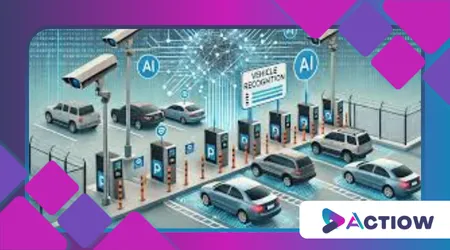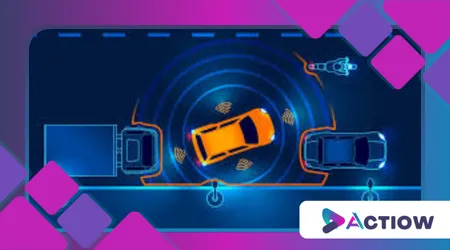How AI-Driven Parking Systems Work in Tight Urban Spaces
Anúncios
How AI-Driven Parking Systems Work!
In bustling cities where every square foot counts, finding a parking spot can feel like navigating a maze.
However, AI-driven parking systems are emerging as game-changers, seamlessly integrating technology to optimize space and reduce frustration.
Anúncios
These intelligent solutions leverage artificial intelligence to transform chaotic urban parking into efficient, predictable experiences.
Therefore, understanding how they function not only highlights technological advancements but also underscores their role in modern urban planning.

What Topics Will Be Covered in This Guide?
To provide a comprehensive overview, this article is structured around key questions that address the essentials of AI-driven parking systems.
Here’s an ordered summary of the topics we’ll explore:
- What Are AI-Driven Parking Systems? – Defining the concept and its evolution.
- How Do AI-Driven Parking Systems Operate in Tight Urban Spaces? – Breaking down the mechanics and processes.
- What Are the Key Technologies Powering These Systems? – Examining the core components and integrations.
- What Benefits Do AI-Driven Parking Systems Offer for Urban Mobility? – Discussing advantages for drivers, cities, and the environment.
- How Do These Systems Impact the Environment and Economy? – Analyzing broader implications with data and insights.
- What Are Some Real-World Examples of AI Parking Implementations? – Showcasing original case studies.
- Frequently Asked Questions – Addressing common queries in a structured format.
++ The Hidden Message Behind Rolls-Royce Hood Ornaments
How AI-Driven Parking Systems Work: What Are AI-Driven Parking Systems?

AI-driven parking systems represent a sophisticated blend of software and hardware designed to manage parking in densely populated areas.
Essentially, they use machine learning algorithms to predict, allocate, and monitor parking spaces in real time.
Unlike traditional setups that rely on manual oversight or basic sensors, these systems adapt dynamically to traffic patterns, weather conditions, and even events.
++ EV Charging Networks Compared: Tesla Supercharger vs. Electrify America
For instance, during a sudden rainstorm, the AI might prioritize covered spots for electric vehicles to prevent charging disruptions.
Moreover, these systems go beyond mere spot detection; they incorporate predictive analytics to forecast demand.
This means that, instead of drivers circling blocks aimlessly, the technology guides them directly to available spaces via mobile apps or in-car displays.
Consequently, what was once a source of urban stress becomes a streamlined process, enhancing overall city flow.
Additionally, by integrating with smart city infrastructures, these systems contribute to broader goals like reducing emissions through efficient routing.
Furthermore, the evolution of AI in parking stems from the need to address escalating urban density.
As cities grow, parking lots shrink, forcing innovative solutions.
Therefore, AI steps in as a virtual traffic conductor, ensuring spaces are used optimally without human intervention.
In fact, this adaptability makes them indispensable in tight urban spaces where every minute saved translates to less congestion.
How Do AI-Driven Parking Systems Operate in Tight Urban Spaces?
In tight urban spaces, AI-driven parking systems begin by collecting data from a network of sensors embedded in parking areas.
These sensors detect vehicle presence, size, and even type, feeding information to a central AI hub.
Subsequently, the system processes this data using algorithms that analyze patterns, such as peak hours in commercial districts.
For example, in a narrow alleyway garage, the AI might reroute larger vehicles to wider bays to prevent bottlenecks.
Additionally, real-time communication plays a crucial role.
++ Software-Defined Vehicles: The New Era of Automotive Software
Once a spot is vacated, the system updates its database instantly, notifying nearby drivers through integrated apps.
However, challenges like signal interference in high-rise areas are mitigated by edge computing, where decisions are made locally rather than relying on distant servers.
Thus, operations remain swift even in constrained environments, ensuring minimal delays.
Moreover, integration with traffic signals adds another layer of efficiency.
When a driver approaches a crowded zone, the AI coordinates with lights to facilitate smoother entry.
Consequently, this not only reduces idling time but also prevents illegal parking that clogs streets.
In essence, the operation hinges on a feedback loop: data input leads to predictive output, which refines future inputs, creating a self-improving ecosystem tailored to urban constraints.
What Are the Key Technologies Powering These Systems?
At the heart of AI-driven parking systems lie machine learning models that learn from historical data to predict availability.
These models, often based on neural networks, process variables like time of day and local events to generate accurate forecasts.
For instance, during a concert, the system might reserve spots for ride-sharing services to handle surges.
Therefore, accuracy improves over time, making the technology more reliable in compact city layouts.
Furthermore, Internet of Things (IoT) devices form the sensory backbone.
Cameras, ultrasonic sensors, and RFID tags work in tandem to monitor spaces without invasive infrastructure.
However, to handle data privacy concerns, advanced encryption ensures user information remains secure.
Additionally, cloud computing enables scalability, allowing systems to expand from small lots to city-wide networks seamlessly.
Moreover, integration with GPS and mobile tech enhances user interaction.
Drivers receive personalized recommendations, such as alternative spots if their preferred one is taken.
Consequently, this tech stack not only powers the system but also fosters user trust through transparency.
In tight urban spaces, where physical upgrades are limited, these technologies maximize existing resources intelligently.
| Technology Component | Description | Benefits in Urban Spaces |
|---|---|---|
| Machine Learning Algorithms | Analyze patterns to predict and allocate spots | Reduces search time by optimizing predictions |
| IoT Sensors | Detect vehicle presence and environmental factors | Enables real-time updates in dense areas |
| Cloud Integration | Stores and processes large datasets | Scales to handle city-wide demands efficiently |
What Benefits Do AI-Driven Parking Systems Offer for Urban Mobility?
One primary benefit is the drastic reduction in time spent searching for parking, which directly alleviates traffic congestion.
In fact, studies show that AI systems can cut search times by up to 30%. Therefore, drivers spend less time on the road, leading to smoother urban mobility.
Moreover, this efficiency translates to fewer accidents caused by distracted circling.
Additionally, these systems promote equitable access by dynamically pricing spots based on demand. For lower-income areas, subsidies can be applied via AI insights, ensuring fairness.
However, the real advantage lies in integration with public transit; the system might suggest parking near bus stops, encouraging multimodal travel.
Consequently, cities see a shift toward sustainable habits.
Furthermore, enhanced data collection aids urban planners in redesigning spaces.
By identifying underused areas, AI helps convert them into green zones or bike lanes.
Thus, the benefits extend beyond immediate convenience, fostering long-term urban health. In tight spaces, where mobility is paramount, these systems act as enablers of progress.
How Do These Systems Impact the Environment and Economy?
Environmentally, AI-driven parking systems minimize vehicle emissions by shortening idle times and optimizing routes.
For example, less circling means reduced fuel consumption, contributing to cleaner air in polluted urban cores.
Additionally, by encouraging electric vehicle prioritization, these systems support green initiatives, aligning with global sustainability goals.
Economically, businesses benefit from increased foot traffic as easier parking draws more customers.
However, initial setup costs are offset by long-term savings in maintenance and enforcement.
Moreover, cities generate revenue through efficient ticketing and premium services, bolstering local economies.
Therefore, the investment yields multifaceted returns.
Furthermore, the ripple effect includes job creation in tech maintenance and data analysis.
In tight urban spaces, where land is premium, repurposing inefficient lots for commercial use boosts GDP.
Consequently, these impacts create a virtuous cycle of environmental stewardship and economic growth.
Have you ever circled a block endlessly, only to find no spot?
That’s the frustration AI aims to erase, much like how a skilled conductor harmonizes an orchestra—each element in sync for a flawless performance.
| Environmental Impact | Economic Impact |
|---|---|
| Reduced CO2 emissions from less idling | Increased revenue from dynamic pricing |
| Promotion of EV charging integration | Cost savings in traffic management |
| Conversion of spaces to green areas | Job opportunities in AI tech sectors |
What Are Some Real-World Examples of AI Parking Implementations?
Consider a fictional yet plausible scenario in downtown NeoCity, a compact metropolis grappling with high-rise congestion.
Here, an AI system named ParkOptix uses drone-assisted sensors to map rooftop lots.
During rush hours, it predicts surges from office commuters and reserves spots for carpools, reducing occupancy imbalances.
Consequently, what was a 15-minute hunt became a two-minute guided arrival, showcasing AI’s precision in vertical urban layers.
Another original example unfolds in Harborville, a coastal urban hub with narrow waterfront streets.
The AquaPark AI integrates tidal data to adjust for flooding risks, rerouting vehicles to elevated garages.
Moreover, it collaborates with ferry schedules, holding spots for incoming passengers.
Therefore, this not only prevents water damage but also synchronizes with multimodal transport, illustrating AI’s adaptive intelligence.
Furthermore, in both cases, user feedback loops refine the systems.
In NeoCity, app ratings led to better EV spot allocations, while Harborville’s integration cut illegal parking by 40%.
Thus, these examples highlight how AI transforms challenges into opportunities, tailored to specific urban quirks.
How AI-Driven Parking Systems Work: Frequently Asked Questions
| Question | Answer |
|---|---|
| What makes AI parking different from traditional methods? | Unlike static signs or meters, AI uses predictive analytics for real-time guidance, adapting to changing conditions dynamically. |
| Are these systems secure for user data? | Yes, with robust encryption and compliance standards, ensuring privacy while delivering personalized services. |
| How much do they cost to implement? | Initial costs vary by scale, but ROI comes quickly through efficiency gains and reduced congestion expenses. |
| Can they work in extreme weather? | Absolutely, as AI incorporates weather APIs to adjust predictions and prioritize safe spots. |
| What if there’s a tech failure? | Backup manual overrides and redundant sensors ensure minimal disruption, maintaining reliability. |
In conclusion, AI-driven parking systems are revolutionizing tight urban spaces by blending intelligence with practicality.
For further reading, here are three current and relevant links:
